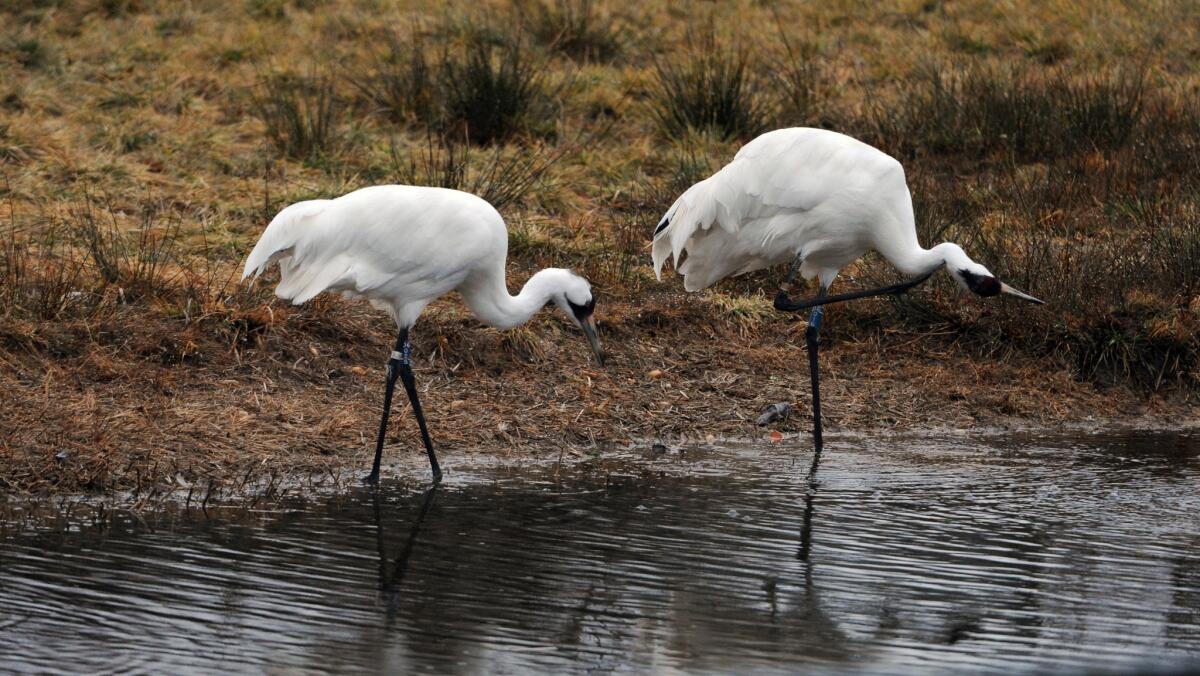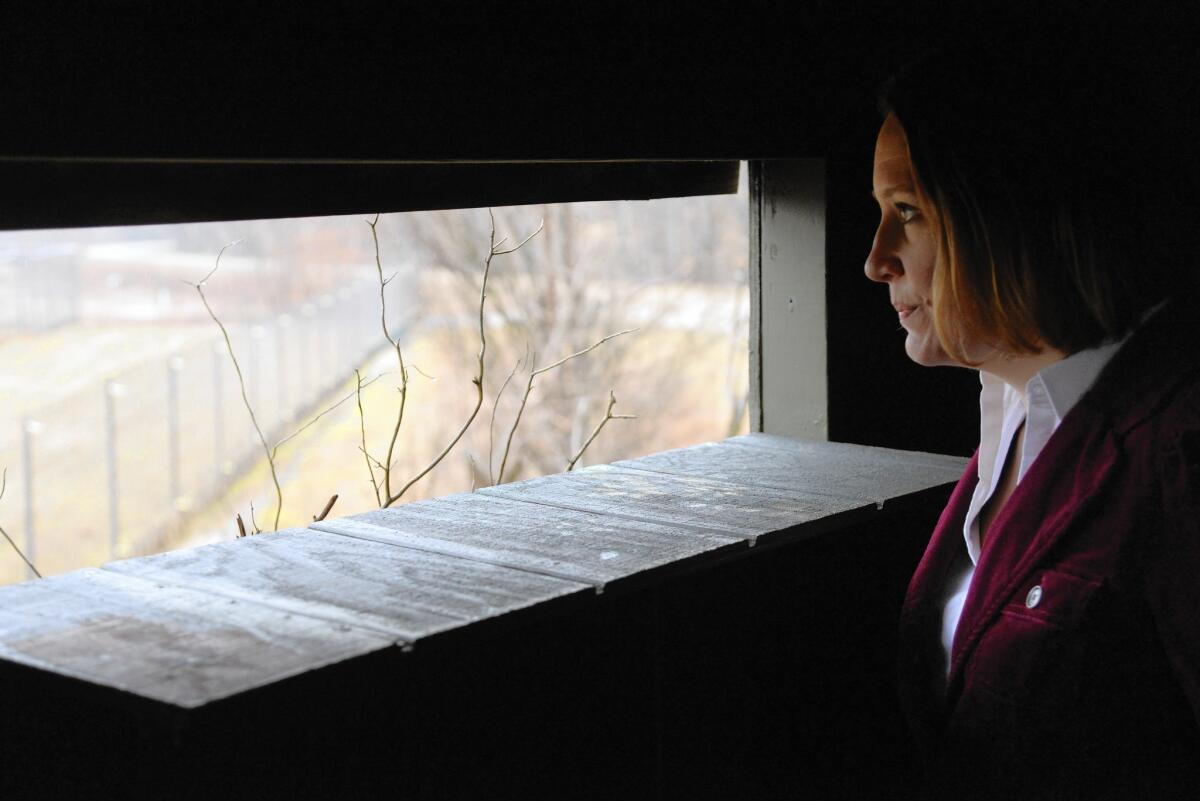There’s no fooling Mother Nature, so whooping crane restoration changes course

A pair of Whooping Cranes at the USCS Patuxent Wildlife Research Center. Ultralight aircraft will no longer be leading the migration of young whooping cranes.
Reporting from LAUREL, Md. — Twenty-five miles south of Baltimore, in a grassy pen enclosed by two rows of fences, electrified to provide protection against raccoons and monitored by video cameras, a pair of the tallest birds in North America emerge from their hut.
Powder-white, all neck and legs, they step through the rain with care, as if in high heels.
For 15 years, staff at the Patuxent Research Refuge near Laurel took an unusual approach to raising endangered whooping cranes: They dressed in crane costumes to teach the chicks to eat like cranes and to drink like cranes. It was elaborate theater to save a species at the brink of extinction.
But something was wrong.
Once released in the wild, the stately birds abandoned their eggs. The speckled chicks died. Researchers lost hundreds of cranes — eggs that failed to hatch, chicks that died — since the project began in 2001. They tried costumes and puppets; they flew ultralight airplanes to lead the migrating cranes south.

It turned out they couldn’t teach parenthood.
“We still can’t do better than Mother Nature,” said Brian Clauss, the flock manager.
In January, federal wildlife officials decided to end the theater. They scrapped the ultralight-led migrations and scaled back the costumed rearing of chicks “to put emphasis on more natural methods of rearing and releasing whooping cranes,” the public-private Whooping Crane Eastern Partnership said.
Now spring approaches, and with it the first eggs will be laid in a popular experiment that’s changed course.
The whooping crane project has been described as a model of conservation. But after years of research comes an acknowledgment: Some of nature’s complexities still lie beyond reach.
The Patuxent refuge, nearly 13,000 acres of marsh and woodlands, was founded in 1936 by President Franklin D. Roosevelt as the first federal reserve devoted to wildlife research.
The first whooping crane, a one-winged male named Canus, arrived in 1966. When he was rescued, the U.S. Geological Survey says, he was one of only 42 whooping cranes left in the wild. Named for the cooperation between Canada and the United States to save the species, Canus went on to sire many of the whooping cranes hatched in captivity.
Breeding efforts expanded in June 2001 with the whooping crane reintroduction project.
The U.S. Fish and Wildlife Service launched the project to raise and train a new population of cranes to be released into the wild for migration from Wisconsin to Florida. Patuxent would raise the chicks.
Whoopers are white with black wingtips and yellow eyes. Their wingspan can reach 71/2 feet. Standing, a grown crane can stare a researcher in the eye.
As many as 20,000 whooping cranes roamed North America before humans interfered, according to the National Wildlife Federation. Their white feathers became high fashion in women’s hats. They were targeted by commercial hunters and sold for meat. Wetlands were drained. A 1941 count found only about 20 birds.
In February last year, the Fish and Wildlife Service counted 603 whooping cranes. But they remain rarer than giant pandas.
Whooping cranes typically lay two eggs at a time. Steal the eggs, and they lay two more. In this manner, researchers can coax six eggs from a pair.
That’s too many chicks for the pair to raise. Also, siblings fight. The stronger chick kills the weaker.
So each spring at Patuxent, Clauss and several other “crane technicians” become surrogate parents to about 30 chicks. They wear white frocks and hoods to conceal their shape so the birds don’t become dangerously comfortable among people.
At hatching, the birds are 5 inches tall and gangly. Clauss carries a puppet crane head, plays recorded crane calls and never speaks a word. He’s Mom.
To teach drinking, he splashes the puppet beak in a water dish. The chick imitates.
For eating, he pokes the puppet head in pellet food. The chick tries.
Next, the chicks are introduced to ultralight airplanes. Costumed pilots drive a grounded plane around a pen. A mechanized puppet head drops mealworms as chicks follow.
Come fall, the young cranes are crated and flown to Necedah National Wildlife Refuge in Wisconsin. Then they fly behind the ultralight to refuges on Florida’s Gulf Coast. After one trip, they remember the route and migrate unassisted the next year.
The January decision changes it all.
“We’re no longer going to do the ultralight release,” said Sarah Converse, a research ecologist at Patuxent. “We’re also moving away, to the greatest degree possible, [from] any costume rearing.”
Problems surface when the grown chicks mate in the wild. Some abandon their eggs. Others abandon their chicks.
So the whooping crane reintroduction project presents a troubling question: What’s broken in the cranes?
“There’s something about these birds’ early learning experiences that affects their breeding,” Converse said. “For example, you’re cared for by your parents, and you learn something that we can’t really teach because we don’t know it. It would take us a long time to understand the intricacies.”
Since the project began in 2001, the researchers have released about 300 whooping cranes. The cranes have hatched 64 chicks in the wild. Only nine have lived to fly.
Federal wildlife officials say the reproductive failure was reason to end the old methods.
The decision was reached at a meeting in Wisconsin of the Whooping Crane Eastern Partnership, a group of federal and state agencies and nonprofits working to restore cranes. Nearly 100 of the birds migrate from Wisconsin to Florida each year, but they fail as parents.
Two other flocks exist. About 40 cranes live year-round in Louisiana. An additional 300 migrate from Canada to the Gulf Coast of Texas.
Without airplanes, puppets or costumes, captive cranes at Patuxent will raise their own chicks until fall. Then juveniles will be shipped to Wisconsin to follow other migrating cranes.
The researchers say the new methods will produce about 25% fewer chicks. At Patuxent, Converse hopes for a dozen this spring.
So researchers are betting these fewer chicks will grow to be better parents.
They say it will take five years before they know.
ALSO
Human Go champion scores 1st win over machine after 3 losses
Snowmobile slams into Iditarod teams, killing one dog and injuring others
As Republican rivals take aim, Donald Trump deflects blame for near-riot in Chicago
More to Read
Sign up for Essential California
The most important California stories and recommendations in your inbox every morning.
You may occasionally receive promotional content from the Los Angeles Times.










